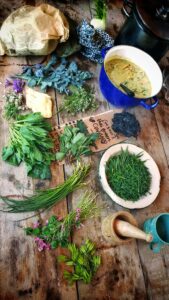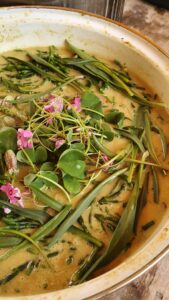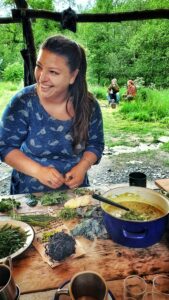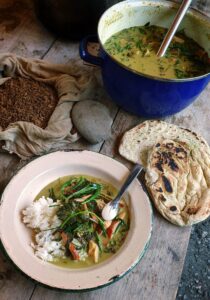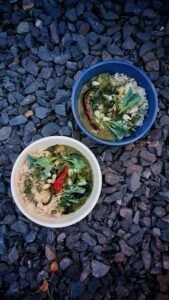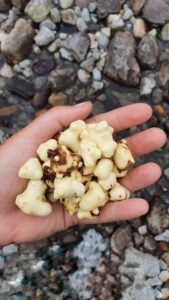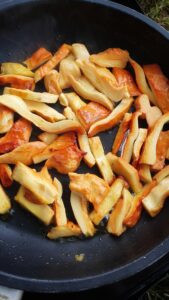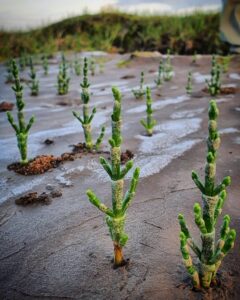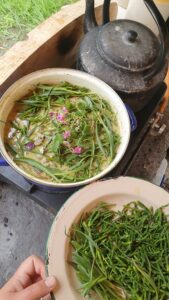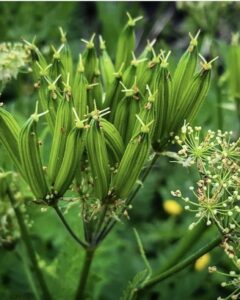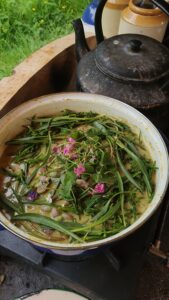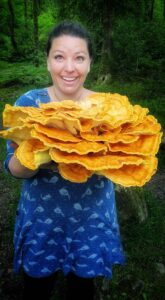Chicken of the woods Thai green curry
Inspiration and authenticity
On my travels, I try to do a cooking class in every country I visit. There’s nothing like learning about a certain cuisine in the region it comes from! The recipe I use as the basis for my paste in this curry comes from a fabulous cooking class I did in Chiang Mai, northern Thailand, probably 15 years ago. Unfortunately I can’t find the school online anywhere (if it’s even still going) so unfortunately I can’t credit them for all the wonderful things they taught me about Thai food (I’ll keep looking though).
Most Thai families’ green curry paste recipes have only about eight ingredients, whereas this one has twice that! This recipe makes one of the best green curries I’ve ever tasted, as long as you can find all the ingredients. I adapted the original recipe to things I can get in Leeds, anyway.
Plan ahead, make the paste in advance
Once I’ve found all the ingredients, I usually spend an evening making loads of paste and then freeze it in ice cube trays, ready to get a couple of blobs out when I feel like a quick dinner! It can take a bit of time so I’d recommend doing it well in advance if you’re having guests over.
The other reason to make loads at once is because you can never get such small quantities of the ingredients in the shops, and as many of them must be fresh they need to be used up within days of purchase, so making a large batch of paste with them is a good idea anyway so as not to waste expensive ingredients.
Once the paste is made, making the curry itself is reasonably quick and easy, 10-15 minutes.
Finding the Thai ingredients
Most good / larger UK supermarkets now stock most of the ingredients fresh. For the more unusual ones, try a south-east-Asian or Chinese supermarket, I use the Sing Kee oriental supermarket we have in Leeds.
On lime leaves
Avoid getting dried makrut lime leaves, they are nothing like the real thing – frozen is good, but many supermarkets do fresh now. Getting those, and the fresh Thai sweet basil, little Thai egg plants and fresh lime leaves is what makes all the difference to the authenticity of the flavour. For me, it’s not a good green curry unless it’s smooth and glossy, and you can clearly taste the zingy lime leaf and the aniseedy basil. Yum yum!!! When I returned from that trip to Thailand I couldn’t get fresh lime leaves anywhere, so I bought a makrut lime tree from a specialist citrus nursery which lives happily in my humid bathroom! I also grew my own sweet basil for years. But now you can get it in most larger supermarkets here.
Another note, in the UK, lime leaves are labelled ‘kaffir’ lime leaves. A South African friend educated me that this term is highly offensive in an African context. The name is not intended to me offensive or derogatory here, but for many around the world, it’s absolutely not a term you use in polite or respectful conversation. The tree is actually called makrut lime, so I use that name. But I include this note because UK readers might not realise makrut lime is the same species as the leaves labelled ‘kaffir’ lime in every single UK supermarket. It’s shocking really, that it’s plastered all over the place here, when you hear what it means in Africa. We need to change this outdated name. Anyway. Makrut it is from here on in! Here’s a bit of background if you’re interested: www.nationalgeographic.com/culture/article/a-food-has-an-historic-objectionable-name-should-we-change-it
Authentic Thai curries are quite thin
Don’t be alarmed if this recipe turns out more liquidy than you expected. In Thailand, we discovered that curries are really quite thin in texture but massive in multi-layered flavour and aromas. I’ve found that restaurants over here tend make their Thai curries thicker and sweeter than necessary, more appealing to the UK diner perhaps (as often also happens with Indian curries too).
If you add too much coconut milk by mistake, or you’d like your curry just a little bit thicker (as I often do) then you can add a heaped teaspoon of cornflour mixed in a small amount of cold water or coconut milk as it simmers, or use arrowroot in the same way. I find this recipe works best in small batches, I’ve not managed to get it right when for more than two people… I’m still practising. Mmm it’s a sooo good and well worth the effort! 🙂
Chicken of the woods
Laetiporus sulphureus, known as chicken of the woods or sulphur shelf, is an amazing fungus for the forager! It tastes of mushroom but has an incredibly meaty texture, perfect for curries! In the UK, it favours oak, followed by cherry and willow (it can help to think ‘C’ cherry, ‘O’ oak and ‘W’ willow!) but people also find it on beech, poplar, larch, pine, and yew. People and books often say avoid on yew, because of toxins in the Taxus species, but there’s no scientific evidence any of us can find to prove this is an issue, in fact an experiment a friend of mine did in the lab suggests there’s nothing extra/toxic present in CotW due to growing on yew wood. But it’s up to you! Regardless of host tree type, you must cook CotW very thoroughly.
If you’ve never had chicken of the woods before, please fry up a small piece, cook it right through, and test your tolerance for it (test it with everyone you’re planning to cook this curry for). Wait 24 hours to check for any gastric upset. If all good (like most people) then you can try more next time. Chicken of the woods *must* be cooked very thoroughly to be safe to eat. Raw or undercooked usually results in a nasty bout of gastric upset for 24-48 hours. This is why we slice it up into small pieces and fry it up in a hot pan before adding to the curry to simmer. I do this to be 100% sure it’s cooked though, as the curry itself never gets vigorously boiled. A very few folk may still not get on with CotW even when cooked properly, so use young fresh fruitbodies and always do a test with a small amount for any new (to you) food.
Razor clams
This recipe also works fabulously with razor clams (or ‘spoots’ as they’re known in Scotland). I use the ‘foot’ muscle, chopped into 1-inch segments, added right at the end of making the curry, so they aren’t over-cooked. I made a spoot green curry with spignel, dulse seaweed & oysterplant garnish, and it was delicious! The saltmarsh veg added raw at the end is also perfect with this delicate fish dish.
Wild meats
You can of course use this recipe to make a meaty curry too, over the years I’ve made versions of this curry with wild meats such as venison; pheasant; wood pigeon; partridge; grouse; mallard (wild duck); rabbit; and hare; as well as high-welfare/organic chicken or beef. The paste and curry method is the same, either way. In the Thai recipe, they slice the meat very thinly so it cooks easily, keeping the curry quick to make, preserving the aromatic flavours as fresh as possible from not cooking for ages.
Halloumi, tempeh and tofu
For the vegetarians, halloumi works brilliantly also! Grill slices or cubes then add to the curry. For the vegans, tempeh (pressed blocks of fermented soy beans left over from tofu making, nutty delicious and way better than tofu IMO), or solid (not silky) tofu also works in this, fry off first like the chicken of the woods for more flavour, or add in as you cook the sauce.
An authentic Thai green curry paste
Serves 2+ depending on how hot you like your curry!
Tip: I suggest scaling this recipe up though and freezing some paste for later
Note: If you reverse the amount of red and green chillies you can turn your green curry paste recipe into a red paste recipe. Also, if you don’t like your curries too spicy, deseed your chillies, and / or use larger chillies.
Ingredients
- 1/2 tablespoon cumin seeds, dry roasted in a wok (no oil, low heat)
- 1/2 tablespoon coriander seeds, dry roasted as above
- 1 tablespoon lemongrass, only use the fat root part
- 1 tablespoon fresh galangal root
- 1 tablespoon lime rind or just zest, grated
- 2 teaspoons coriander root
- 2 tablespoons shallots, minced or finely chopped (ideally the tiny thai shallots, but any will do if not)
- 6 garlic cloves, minced, with hard end, skin and any green bits inside removed
- 2 centimetres fresh turmeric root (quite different to the dried powder)
- 6-8 centimetres fresh krachai (or ginza), skin removed (or substitute old dull-skinned ginger)
- 5 Thai sweet basil leaves (I add the stems too!)
- 1-2 medium red Thai ‘finger’ chillies (bird’s eye is fine) (I deseed mine, but if you like it hot, leave them in)
- 10-15 medium green Thai ‘finger’ chillies (bird’s eye is fine) (as above, I deseed mine)
- 1 teaspoon salt
- 1 teaspoon shrimp paste (will keep for a year in fridge – omit for veggies – or use a mushroom garum/vegan/umami paste etc)
Preparation
Note: I find bashing the ingredients makes a difference, you can always pop it in a food processor afterwards if you like, but I highly recommend pounding by hand in a large heavy pestle & mortar first if you can, rather than just chopping it all in a whizzer, bruising and smooshing releases more flavour
Note: this paste will stain everything wooden or plastic that it touches bright yellow for a while due to the turmeric!
- In a pestle and mortar, pound ingredients until paste appears even
- This paste is enough to make a generous serving for two people.
- You can keep the paste for one week in the fridge, or three to twelve months in the freezer. Make a larger batch and freeze in ice cube trays for easy use (trays you never want back for ice ever again, they will be stained bright yellow by the turmeric!)
Thai green curry with chicken of the woods & saltmarsh greens
Serves 2 when served with rice or flat-breads
Note: This recipe uses ‘cups’ (1 cup = approx 250ml), but I find that for two people, one *unshaken* tin of coconut milk at UK room temperature tends to provide enough solid cream at the top and I later use *nearly* all of the clear milk, saving a little back as it usually goes too thin if I use all of it
Tip: Use a 400ml can of good quality, full-fat coconut milk for this, so you can get the cream off the top, cheap ones are very thin with not much cream
Tip: Don’t shake your can of coconut milk! You need it separate.
Ingredients
- 1/2 cup thick coconut cream (usually solid at UK room temperature, so you can get it from top of your coconut milk can if you don’t shake it)
- 1/2-1 tablespoon green curry paste (see recipe above, break it up and allow to defrost if frozen, better at room temperature but not essential)
- 200g fresh chicken of the woods mushroom chopped to bite-size pieces (or you can use pheasant, venison, pigeon, other meaty mushrooms, spoots/razorclams, limpets, mussels, scallops, langoustines, lobster, tempeh, whatever ‘protein’ you like! – see more notes in intro)
- (Up to) 2 cups thin coconut milk (or, most of the rest of a UK can after solid the cream is skimmed off, not quite all of it… add in dribbles and see how it looks)
- 2 makrut lime leaves (or ‘kaffir’ in UK, see name note in intro), sliced as thinly as possible in strips (roll up tightly then chop finely)
- 1/2 tablespoon of coconut sugar (you can substitute golden or soft brown sugar)
- 2 tablespoons fish sauce ‘nam pla’ (or to taste, they vary, do a bit at a time and taste) (substitute 1 tablespoon soy sauce, umami sauce, or mushroom garum / shoyu / ketchup for vegetarians – I used my homemade koji cep shoyu)
- 1 large red chilli (not as hot as the small ones!), thinly sliced
- 20 leaves Thai sweet basil & chopped stems (smells of aniseed – not to be confused with Thai holy basil or European basil – you could use sweet cicely, tarragon or fennel leaves, but not quite the same kind of aniseed!)
- 1 tablespoon sweet cicely pods, young, flexible, green
- A handful of pignuts, washed, papery skin removed & chopped into bite-size pieces
- 100g fresh saltmarsh greens and sea veg (you can easily buy samphire in the supermarket these days, but I used wild foraged goodies in mine: marsh samphire; sea arrowgrass/coriander grass; sea aster leaves; sea kale leaves; sea beet leaves & tips; wild garlic leaves, stems & green pods… but use whatever you have and like!)
- Flowers for decoration (I used: sea campion flowers; common mallow flowers, pink sorrel leaves & flowers; coriander grass unopened flowers buds; pignut flowers & sea radish, which is just what I had that day, use whatever you have & like!)
Preparation
Note: Always cook your curry uncovered and stir it constantly while cooking. This goes for any dish made with coconut milk or cream as the coconut fat can separate from the water appearing to have curdled. So just relax and take it slow! 🙂
- Put your rice on to cook (follow whatever instructions your type of rice needs).
- Cook your chicken of the woods first. Use oil and a high heat, making sure it is *cooked thoroughly* (under-cooked CotW can cause gastric upset).When the CotW is cooked, remove from the pan & set aside
- Turn to a medium heat, add a splash of water to the hot pan and add the sweet cicely pods, and anything like sea kale and sea beet, that needs cooking through. Sauté until veg is bright green and soft enough to easily bite through. Set aside and wipe out the wok or pan.
- Turn stove to a low heat and put the thick coconut cream into the clean wok. Stir gently.
- When you can see oil droplets starting to appear in the cream, add the curry paste and mix well, watching for when you can smell the aromas coming out. This will take longer if your paste is cold or frozen as it will cool the cream again. You get better results and flavour if the paste is not cold.
- When you can smell the aromas in the paste, add the chicken of the woods and turn gas to a medium heat (still taking care against curdling). Your CotW is already cooked so just warm it through again, until your curry is starting to simmer nicely. (If using any thinly-sliced meat e.g. pheasant, duck, pigeon or venison, or actual chicken, medium-heat fry longer at this stage until the meat changes colour and texture).
- Then add the thin coconut milk, makrut lime leaves, coconut sugar and fish sauce (or shoyu/substitute salty umami sauce).
- Stir constantly for ten minutes. When the curry boils and foams up at the edges, turn the gas to low so that the curry is left to simmer for the remainder of the ten minutes.
- After ten minutes, stir in the cooked sweet cicely pods, sea beet, sea kale, thai basil leaves, red chilli & pignuts. Switch off the gas immediately.
- Whilst still hot, top with the raw saltmarsh veg such as samphire, sea aster, sea purslane, sea arrowgrass etc. You just want these to just warm through with the residual heat in the curry, not really to cook much.
- Right before serving, garnish with the foraged flowers etc if you have any.
- Serve fairly immediately with steamed Thai jasmine rice or Thai red rice (or whatever rice you have/ like). Flatbreads are also nice with it, we had stone-baked flatties with nettle seed and seaweed powders on. Great just with rice too though!


